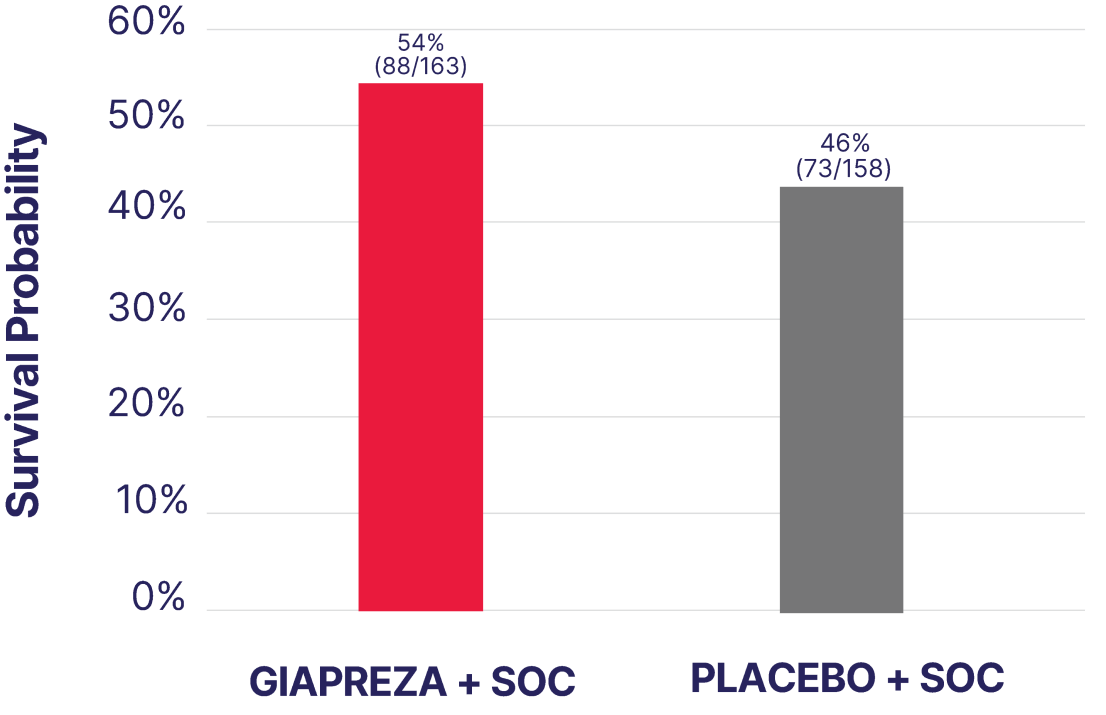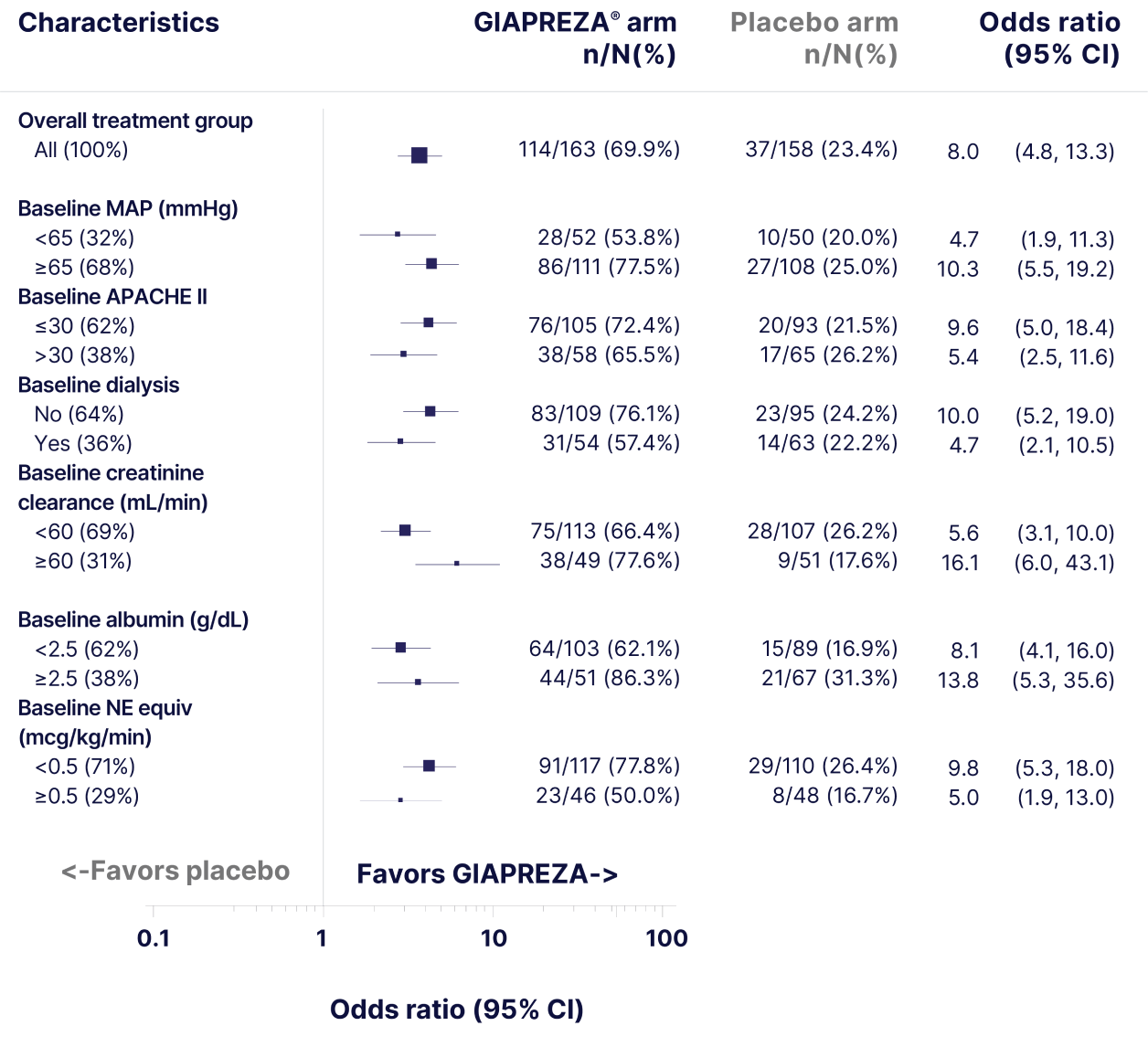Efficacy
The first and only
vasopressor of its kind
Trial Design
A landmark trial for distributive shock1
GIAPREZA was studied in ATHOS-3, an international, randomized, double-blind, placebo-controlled study of 321 patients with distributive shock, who remained hypotensive despite fluid and vasopressor therapy.2
Slide table to view more
Treatment arms2 GIAPREZA (n=163) plus standard-of-care (SOC) vasopressors*,† Placebo (n=158) plus standard-of-care (SOC) vasopressors*,† | Primary endpoint2: An increase in MAP at Hour 3 of at least 10 mmHg, or a MAP response of ≥75 mmHg, without an increase in baseline vasopressor dosing. |
Secondary endpoints2: - Mean change in cardiovascular SOFA score at Hour 48 - Mean change in total SOFA score at Hour 48 | |
Select additional endpoint2: All-cause mortality through Day 28. |
Slide table to view more
| Select baseline patient characteristics (N=321)2 | GIAPREZA + SOC (n=163) | Placebo + SOC (n=158) |
|---|---|---|
| Median MAP, mmHg (IQR) | 66.3 (63.7-69.0) | 66.3 (63.0-68.3) |
| Median APACHE II score (IQR) | 27 (22-33) | 29 (22-34) |
| Cause of shock, sepsis (%) | 127 (77.9%) | 132 (83.5%) |
| Median vasopressor dose (NED), mcg/kg/min (IQR) | 0.33 (0.23-0.56) | 0.34 (0.23-0.56) |
| Vasopressin use during 6 hours before randomization (%) | 113 (69.3%) | 111 (70.3%) |
*Standard-of-care vasopressors included norepinephrine, epinephrine, dopamine, phenylephrine, and vasopressin.
†Doses of GIAPREZA or placebo were titrated to a target MAP of ≥75 mmHg during the first 3 hours of treatment while doses of other vasopressors were maintained. From Hour 3 to Hour 48, GIAPREZA or placebo was titrated to maintain a MAP between 65 and 70 mmHg while reducing doses of other vasopressors.
APACHE II=Acute Physiology and Chronic Health Evaluation II; ATHOS-3=Angiotensin II for the Treatment of High‑Output Shock; IQR=interquartile range; NED=norepinephrine-equivalent dose: the sum of all vasopressor doses with each vasopressor dose converted to the clinically equivalent norepinephrine dose; SOFA=Sequential Organ Failure Assessment.
MAP Response
3x more patients achieved and sustained target MAP2
Slide table to view more
Median time to reach target MAP was 5 minutes
Rapidly stabilize MAP and reduce vasopressor needs2
70% of patients who achieved target MAP reached it within the first 30 minutes of treatment at doses ≤5 ng/kg/min3
During the first 48 hours, patients on GIAPREZA required consistently lower mean doses of background vasopressors2
The effect on MAP was sustained for at least the first 3 hours of treatment


Survival Data
Increased patient survival at day 282,4
Slide table to view more

A meta-analysis found no difference in mortality rates between angiotensin II and norepinephrine (46.2% vs. 54.2%; RR, 0.85 [95% CI, 0.69-1.06])
-2021 SSC Guidelines5,*
Not statistically significant. Mortality through Day 28 was an exploratory endpoint in ATHOS-3. The study was not powered to detect a difference in mortality. There were secondary endpoints not reported on this website.2
*The SSC released updated global guidelines in October 2021 for clinicians caring for adult patients with sepsis or septic shock.5
There was a higher incidence of arterial and venous thrombotic and thromboembolic events in patients who received GIAPREZA compared to placebo-treated patients in the ATHOS-3 study (13% vs. 5%).
Survival benefit was greatest when
initiated with lower vasopressor doses6
In an exploratory post hoc analysis of ATHOS-3, early use of GIAPREZA plus standard of care was associated with improved survival vs. placebo plus standard of care.6
Slide table to view more
For complete Safety Information of GIAPREZA, click here.
DON’T WAIT—start GIAPREZA sooner to help reduce mortality and lower doses of other vasopressors.6
Subgroup Results
Powerful results in a broad range of patients
Slide table to view more

Patients with a history of ACEi and ARB favored GIAPREZA over placebo but interpretation should consider the small sample sizes (9% and 7%, respectively).
Note: The figure above presents effects in select subgroups, all of which are baseline characteristics. The 95% confidence limits that are shown do not take into account the number of comparisons made and may not reflect the effect of a particular factor after adjustment for all other factors. Apparent homogeneity or heterogeneity among groups should not be over-interpreted.
ACEi=angiotensin converting enzyme inhibitor; ARB=angiotensin II receptor blocker; CI=confidence interval.
RAAS Outcomes
A catecholamine-sparing agent to target RAAS and increase patient survival4,7,8
In an exploratory post hoc analysis of ATHOS-3, a shock-disrupted RAAS pathway was confirmed as a key contributor to low MAP. The analysis uncovered abnormally high renin levels and ANG I/II ratios, suggesting RAAS dysfunction, which correlated with a much higher risk of mortality.7
renin levels7
limit of normal7,*
High renin levels correlated with7:
Slide table to view more
| GIAPREZA effectively reduced renin and ANG I levels for better outcomes7: | GIAPREZA + SOC | Placebo + SOC |
|---|---|---|
| Reduction in serum renin levels, % | 54.3 | 14.1 |
| Reduction in serum ANG I levels, % | 39.7 | 7 |
| 28-day mortality, % [median (IQR)]† | 51 (39-65) | 70 (59-80) |
| Ventilator liberation by Day 7 (alive and ventilator-free), % [median (IQR)]† | 28 (18-43) | 14 (8-25) |
| RRT liberation by Day 7 (alive and RRT free), % [median (IQR)]† | 43 (25-66) | 12 (5-27) |
| ICU discharge by Day 28, % [median (IQR)]† | 44 (32-58) | 22 (14-33) |
*The upper limit of normal was defined as 58.78 pg/mL; the median renin level was 172.7 pg/mL.7
†Values represent outcomes in patients who had renin concentrations above the study population median.7
RRT=renal replacement therapy.
Connect with a GIAPREZA sales
representative for information and support.
References:
- Andrews L, Benken J, Benedetti E, et al. Effects of angiotensin II in the management of perioperative hypotension in kidney transplant recipients. Clin Transplant. 2022;36(9):e14754. doi: 10.1111/ctr.14754
- Khanna A, English SW, Wang XS, et al. Angiotensin II for the Treatment of Vasodilatory Shock. N Engl J Med. 2017;377(5):419-430. doi: 10.1056/NEJMoa1704154
- Ham KR, Boldt DW, McCurdy MT, et al. Sensitivity to angiotensin II dose in patients with vasodilatory shock: a prespecified analysis of the ATHOS-3 trial. Ann. Intensive Care. 2019;9(1):63. doi: 10.1186/s13613-019-0536-5
- Supplementary appendix to: Khanna A, English SW, Wang XS, et al. Angiotensin II for the Treatment of Vasodilatory Shock. N Engl J Med. 2017;377(5):419-430. doi: 10.1056/NEJMoa1704154
- Evans L, Rhodes A, Alhazzani W, et al. Surviving sepsis campaign: international guidelines for management of sepsis and septic shock 2021. Intensive Care Med. 2021;47(11):1181-1247. doi: 10.1007/s00134-021-06506-y
- Wieruszewski PM, Bellomo R, Busse LW, et al. Initiating angiotensin II at lower vasopressor doses in vasodilatory shock: an exploratory post‑hoc analysis of the ATHOS-3 clinical trial. Crit Care. 2023;27(1):175. doi: 10.1186/s13054-023-04446-1
- Bellomo R, Forni LG, Busse LW, et al. Renin and Survival in Patients Given Angiotensin II for Catecholamine-Resistant Vasodilatory Shock. A Clinical Trial. Am J Respir Crit Care Med. 2020;202(9):1253-1261. doi: 10.1164/rccm.201911-2172OC
- Buckley MS, Barletta JF, Smithburger PL, et al. Catecholamine Vasopressor Support Sparing Strategies in Vasodilatory Shock. Pharmacotherapy. 2019;39(3):382-398. doi: 10.1002/phar.2199
Important Safety Information
Indication
GIAPREZA® (angiotensin II) increases blood pressure in adults with septic or other distributive shock.
Contraindications
None.
Warnings and Precautions
The safety of GIAPREZA was evaluated in 321 adults with septic or other distributive shock in a randomized, double-blind, placebo-controlled study, ATHOS-3. There was a higher incidence of arterial and venous thrombotic and thromboembolic events in patients who received GIAPREZA compared to placebo-treated patients in the ATHOS-3 study (13% vs. 5%). The major imbalance was in deep venous thromboses. Use concurrent venous thromboembolism (VTE) prophylaxis.
Adverse Reactions
The most common adverse reactions reported in greater than 10% of GIAPREZA-treated patients were thromboembolic events. Adverse reactions occurring in ≥4% of patients treated with GIAPREZA and ≥1.5% more often than placebo‑treated patients in the ATHOS-3 study were thromboembolic events (including deep vein thrombosis), thrombocytopenia, tachycardia, fungal infection, delirium, acidosis, hyperglycemia, and peripheral ischemia.
Drug Interactions
Angiotensin converting enzyme (ACE) inhibitors may increase response to GIAPREZA. Angiotensin II receptor blockers (ARBs) may reduce response to GIAPREZA.
You are encouraged to report negative side effects of prescription drugs to the FDA.
To report SUSPECTED ADVERSE REACTIONS, please contact:
Before administering, please see the Full Prescribing Information for GIAPREZA.